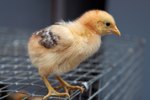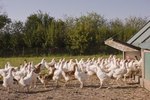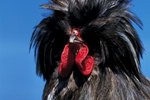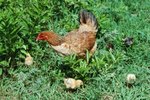Unless you're a big show-chicken fan you might not be aware more than 200 different breeds of chickens exist. Most roosters look basically the same, but it's interesting to note what makes an Asil rooster, for example, unique from other breeds. When you know more about Asil roosters, it becomes clear why they were important to cultures in centuries past and why their characteristics make them important to modern poultry breeds.
Ancient Origins
Asil roots run long and deep, having originated in India in the 1400s. In her 2013 book on raising chickens, Christine Heinrichs explains that the specific origins of Asils or Aseels are so intertwined with two other Indian breeds it's not known which breed came first, it's possible that the Asils date back as far as 3,500 years.
Physical Characteristics
The physical characteristics of Asil roosters give them a distinct look. Like all roosters, they have pea combs; but Asils have sizeable necks and small wattles. Their shoulders and hips are prominent and broad; they have thick, muscular thighs set on sturdy legs. Asils are solid birds medium in size. While some roosters can get as big as 15 pounds, Asils top out around 6 pounds. Asil roosters come in a variety of colors, as the names of their types suggest: wheaten, white, dark, black-breasted red and spangled.
Fighting Birds
Ancient Indian writings refer to cockfighting as a popular pastime of the age, and Asils were the roosters of choice for the sport. With their aggressive, confrontational nature, it's easy to see why. Asil roosters always have to be penned separately, otherwise fights will occur and blood will flow.
Benefits to Other Breeds
In the mid 1800s, Cornish farmers set out to breed a game bird that was stronger than their established gamecocks. To accomplish this, they crossbred their chickens with Asil roosters. The result was a new Cornish fowl with short legs but substantial thighs and a large, strong neck set atop a wide chest and broad shoulders.
References
- Raising Chickens for Dummies; Kimberly Willis, Rob Ludlow
- The Encyclopedia of Historic and Endangered Livestock and Poultry Breeds; Janet Vorwald Dohner
- How to Raise Chickens: Everything You Need to Know, Updated & Revised; Christine Heinrichs
- Mother Earth News: Cornish Game Chickens: Heritage Poultry Breeds
Writer Bio
Elle Di Jensen has been a writer and editor since 1990. She began working in the fitness industry in 1987, and her experience includes editing and publishing a workout manual. She has an extended family of pets, including special needs animals. Jensen attended Idaho and Boise State Universities. Her work has appeared in various print and online publications.





